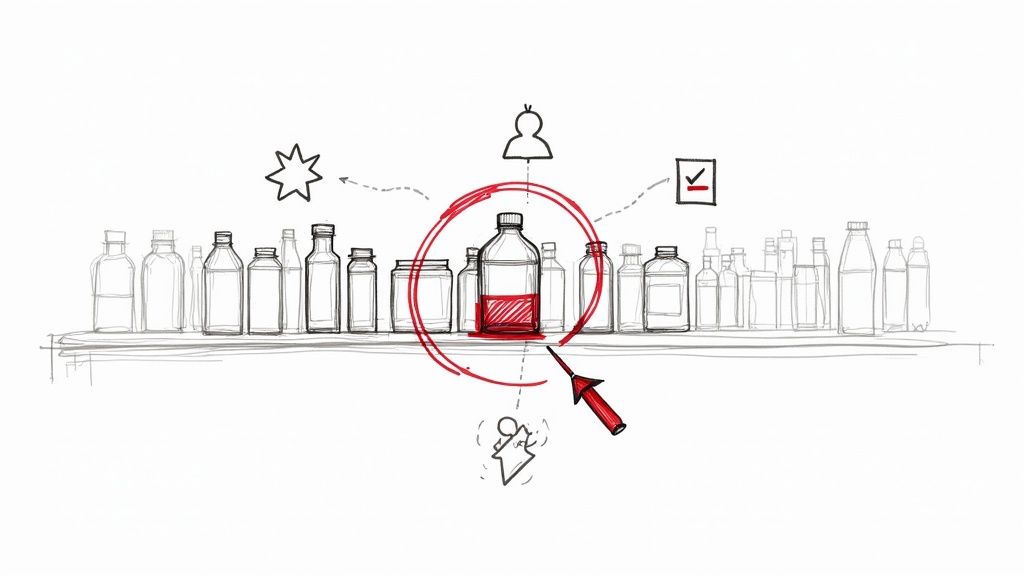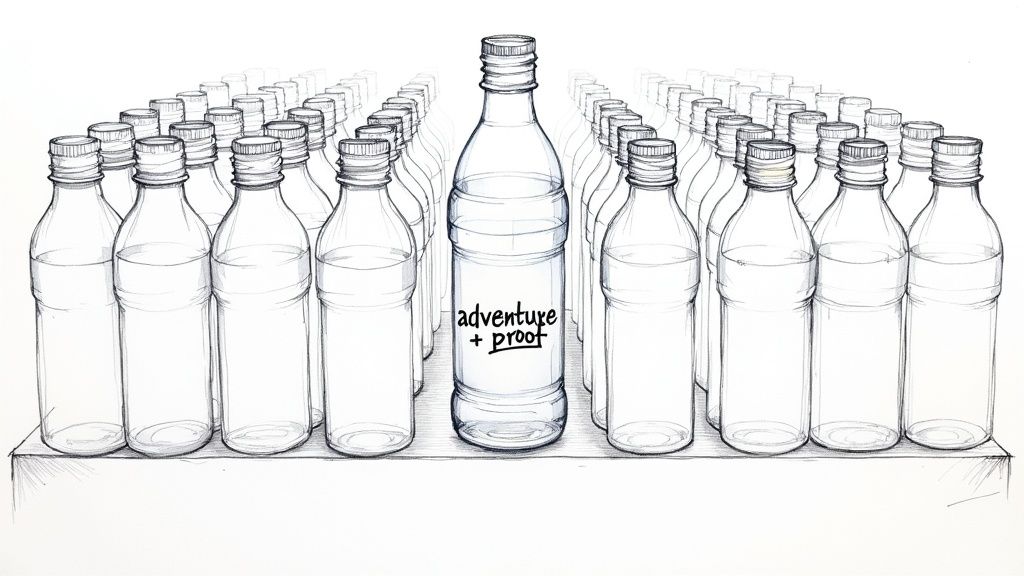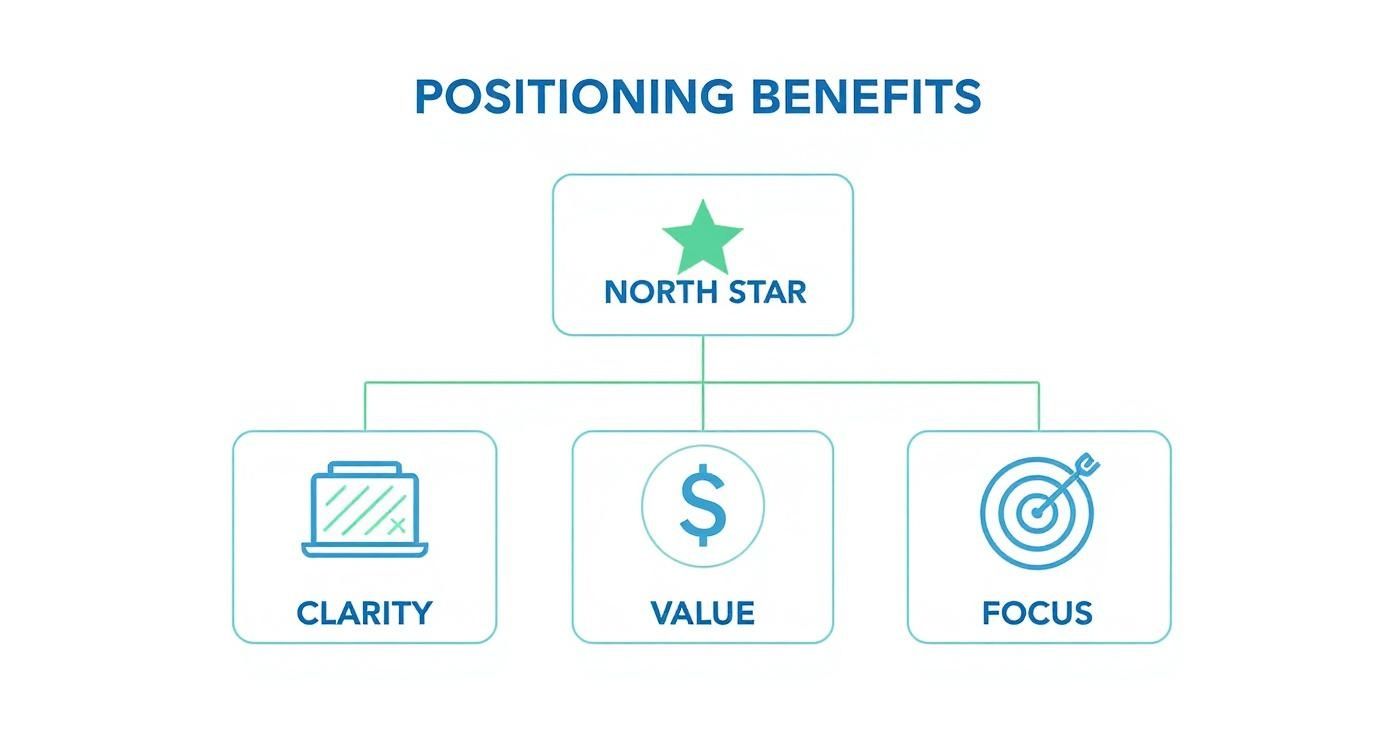What Is Product Positioning and How to Do It Right
What is product positioning? Learn how to find your unique spot in the market with clear examples and a simple process to make your product stand out.

Let's cut the fluff. Product positioning is about making your product the only choice for a certain customer. It’s about carving out a spot in their brain so when they have a problem, your brand is the first thing that pops into their head.
So, What Is Product Positioning, Really?

Imagine you walk into a store to buy water. There's a whole aisle of it. They all hold water. So why does one person grab the rugged, military-grade bottle for their camping trip, while another picks the sleek, minimalist one that screams "I do yoga"?
That, my friend, is positioning. It’s not just about what a product does. It's the unique story it tells and the specific promise it makes to a very specific person.
> Product positioning is the dark art of deciding how you want your ideal customers to see your brand compared to everyone else. It's less about a list of features and more about owning a piece of mental real estate.
This isn't some new-age marketing fad. The idea has been around since the 1960s, made famous by Jack Trout and Al Ries in their book, Positioning: The Battle for Your Mind. They're the ones who figured out how to get noticed in a noisy world. If you want to see how this plays out, check out these real-world case studies that show its impact over the years.
Let's Break It Down
When you strip away the jargon, product positioning answers three crucial questions for your customers before they even bother to ask:
- Who is this for? (Hint: if you say "everyone," you're doomed.)
- What specific problem does this solve for me? (The more specific, the better.)
- Why is this better than the other guys? (This is your secret sauce.)
Think of it as your product's superhero origin story, its mission, and its superpower all rolled into one simple idea. Nailing this makes every other marketing decision—from your logo to your ads—way easier. It becomes the North Star for your entire marketing plan.
Why Good Positioning Is Your Secret Weapon
Okay, you get the gist. But is all this strategic navel-gazing really worth it? In a word: hell yeah.
Strong product positioning is the difference between yelling into a void and having the right people lean in to listen. It’s like a bouncer for your brand—it ushers in the customers who totally get you and politely shows the door to those who don’t.
This kind of clarity is a superpower. It lets you charge what you're worth because you’re no longer just another generic option. It also saves you from burning cash trying to be everything to everyone.
> Think of your positioning as your business's North Star. It keeps your product, marketing, and sales teams all rowing in the same direction, saving you a massive amount of time, money, and headaches down the road.
From Vague Idea to Clear Advantage
Without clear positioning, you're just throwing spaghetti at the wall. You waste money on marketing that doesn't hit and build features nobody asked for. But once you have it, you gain a sharp focus that unlocks some serious perks.
- Premium Pricing: When you own a niche, you sidestep the race to the bottom on price. People will happily pay more for the perfect solution than for a generic one.
- Simplified Marketing: Suddenly, you know exactly what to say, where to say it, and who to say it to. Your message gets consistent and powerful.
- Customer Loyalty: Customers who feel like a product was made just for them become raging fans. They stick around longer and brag about you to their friends.
Getting a handle on the competitive landscape is a huge part of this. When you're ready to dig in, learning how to conduct competitive analysis is your first step toward carving out that unique spot in the market. Your secret weapon also includes your brand's core elements; understanding the strategic importance of a strong brand name is fundamental for making a real impact.
The Three Pillars of Powerful Positioning
Alright, let's get into the guts of it. Powerful positioning isn’t magic. It’s a structure built on three essential pillars. Get these right, and you're golden.
Think of it like building a stool. If one leg is wobbly, the whole thing crashes. Same deal here.
Pillar 1: Your Target Audience
First up: Who are you really for? And please, for the love of all that is holy, don't say "everyone." We need to get creepy-specific, way beyond "millennial women."
What keeps them up at night? What are their secret hopes and frustrations related to the problem you solve? You need to understand their world to become their only choice.
This infographic breaks down how nailing your positioning—starting with your audience—brings clarity, value, and focus to your business.

As you can see, everything flows from a single guiding principle, making your strategy coherent and strong.
Pillar 2: Your Unique Differentiator
Next, what is the one thing you do better than anyone else for that specific audience? This isn't a laundry list of features. It’s your secret sauce.
Maybe you’re the fastest. Maybe you’re the easiest to use. Maybe your customer service is so good people write songs about it. Whatever it is, it must be something your target audience genuinely cares about.
> This is where you draw a line in the sand and declare, "This is our turf." It’s the compelling reason a customer chooses you over a nearly identical competitor.
Defining this often requires mapping out where you stand against others. To get a clearer picture of your competitive space, you might find a marketing positioning matrix incredibly helpful for visualizing your unique spot.
Pillar 3: Your Value Proposition
Finally, what is the clear, undeniable promise you make? This is the core benefit they get from choosing you, boiled down into a simple idea. It's the answer to their selfish question: "What's in it for me?"
It connects your differentiator directly to your audience's pain. For example, a value proposition isn't "We use AI algorithms." It's "Get your weekend back with automated report building." See the difference? One is a feature, the other is a benefit.
This isn’t just marketing fluff; it has a real impact. In fact, clear product positioning can boost market penetration by over 30% in the right customer segments. When these three pillars work in harmony, you create an unshakeable position in the market.
Real World Examples of Positioning Genius

Theory is great, but seeing positioning in the wild is where it all clicks. Let's look at a few brands that absolutely crushed it.
First, the undisputed champ: Apple. Remember when computers were just clunky, beige boxes for nerds? They were boring, complicated, and deeply uncool.
Then Apple kicked down the door. With their iconic "1984" Super Bowl ad and the later "Think Different" campaign, they weren't selling technical specs; they were selling an identity. Their positioning was brutally effective: a PC is for work, but a Mac is for creators. They sold rebellion for every artist, musician, and weirdo out there.
The Modern Disruptor: Liquid Death
For a newer—and funnier—example, look at Liquid Death. Let's be real: it's water. In a can. But the way they positioned it is genius. While every other water brand whispered about mountain springs, Liquid Death showed up looking like a heavy metal band's energy drink.
Their slogan, "Murder Your Thirst," says it all.
- Target Audience: Punks, skaters, metalheads, and anyone sick of polished corporate vibes.
- Competitor: Every boring plastic water bottle on the shelf.
- Differentiator: A loud, irreverent attitude that makes drinking water feel like an act of rebellion.
They didn't position water as a health product. They positioned it as an entertainment brand. And in doing so, they became impossible to ignore.
The Everyday Essential: Dollar Shave Club
Remember the nightmare of buying razors? You'd go to the store, find the blades locked up like they were crown jewels, and then pay a fortune for them. Dollar Shave Club saw that frustration and pounced.
Their positioning had nothing to do with more blades or a vibrating handle.
> It was about being the smart, simple, and cheap alternative to the overpriced giants. Their legendary launch video instantly cast them as the funny, no-BS solution for regular guys who were tired of getting ripped off.
They weren't just selling razors; they were selling convenience and membership to a club that was in on the joke.
These examples prove a critical point: killer positioning isn't always about having the "best" product. It's about owning the best story in your customer's mind.
How to Define Your Product's Positioning
Alright, enough talk. Let’s get our hands dirty. This isn't about waiting for a lightning bolt of inspiration; it's a simple, repeatable process.
Our goal is to create a clear positioning statement. Think of this as an internal cheat sheet, not a flashy billboard tagline. It's your secret recipe.
The 5-Step Formula for a Killer Positioning Statement
The easiest way to do this is to just fill in the blanks. Grab a whiteboard and answer these five questions with brutal honesty. No fluff.
- FOR [Your Target Customer]: Who is the exact person who gets the most value from what you sell? Be laser-focused. This is so important that we have a full guide on how to define your target audience to help you nail this.
- WHO NEEDS [Their Main Problem]: What’s the nagging, frustrating problem that keeps them up at night? What are they desperate to solve?
- OUR PRODUCT IS A [Product Category]: What kind of "thing" are you? A project management tool? An accounting software? A high-caffeine coffee brand? Be clear.
- THAT PROVIDES [Your Key Differentiator]: This is your secret sauce. What’s the one big benefit you deliver that no one else can?
- UNLIKE [Your Main Competitor(s)]: Who is the alternative they're probably using now? Naming your rival makes your position much stronger.
> Putting it all together gives you a powerful statement: For [target customer] who needs [to solve a problem], our product is a [category] that provides [unique benefit] unlike [the competitor].
This simple framework forces you to be crystal clear. It makes you confront who you're for, what you solve, and why you’re the only real choice. Understanding your audience is absolutely critical, which is why we’ve put together a guide on how to identify target customers to help you lock in that first crucial piece.
You don't need a huge budget for this, either. Sure, professional tools like Ahrefs or Semrush are great, but they can be expensive. You can start by simply talking to your customers or digging through online reviews.
For a more accessible way to understand the competitive landscape without breaking the bank, a platform like already.dev can give you the insights you need.
A Few Final Questions About Product Positioning
Alright, let's wrap this up by hitting a few common questions. No fluff, just quick answers.
Positioning vs. Branding: What’s the Real Difference?
Think of it this way: positioning is the strategy, and branding is the stuff you actually see and feel.
Positioning is the secret decision you make to be "the safest car on the road." Branding is the serious logo, the ads with happy families, and the reassuring tone of voice you use.
> In short, positioning is the blueprint. Branding is the paint, furniture, and decorations.
How Often Should I Revisit My Positioning?
Great question. You shouldn't change it every week, but it's not set in stone forever.
Give your positioning a check-up once a year or whenever there's a major shift in your market, like a scary new competitor or a big change in what customers want. If your positioning still rings true and makes you money, don't mess with it.
Can a Product Have More Than One Position?
Nope. Trying to do this is a recipe for disaster. You need one core positioning statement to be your North Star.
Trying to have multiple positions is like trying to be both the cheapest option and the most luxurious. It's confusing, and nobody will believe you.
You can, however, create different messages that come from that single position. The core idea stays the same, but you might highlight different benefits for different audiences—you're just telling the story a little differently without changing the plot.
Ready to uncover your unique spot in the market? Already.dev uses AI to do the heavy lifting of competitive research, giving you the insights you need to build a winning position in minutes, not weeks. Find out how it works.